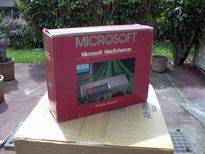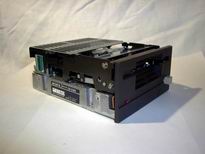
![]()
![]()
![]()
![]()
![]()
![]()
![]()
![]()
![]()
![]()
|
The Mac Geek's Journal - Archives Archived November 3, 2002
2003_11_10
|
|
11/03/2002 - The Community BBS is in Public Beta After several
months of finding the right software package, installing, configuring,
programming, and creating graphics, I'm finally very happy to announce the
public beta of the Community Bulletin Board System (CBBS). The CBBS is simply a cyberspace method for people of certain interests to interact with one another. One of the principles of life I truly follow is the exchange of ideas, opinions, and solutions between people. I've been doing that very thing, communicating via on-line bulletin boards for over 20 years, so I'm quite used to the concept. I'm providing the CBBS to continue my quest for the spreading of information, and uniting people with the same interests. Take a tour of the CBBS. Click on this link to get to the CBBS. Feel free to browse through the various forums available. As part of the public beta, I've provided sample forums for Apple Collectors, programmers (HAPA), and HMAUS members. The CBBS is going to be a permanent thing, so please by all means register and start posting your ideas, problems, and solutions. The public beta is meant as a means of bullet testing the system for stability and measurement of public response. To fully utilize the CBBS, registration is required. You do not need to register just to read the forum message. To do anything else worthwhile does, such as posting to the forums, or sending private message to other CBBS members. Registration is absolutely FREE, and is quite secure. To register, click on this link or click on the "Register" link on any of the CBBS pages. I promise, I will not give your e-mail address or other information to other parties. The really cool thing about the CBBS is that the message stay on-line FOREVER, and is fully searchable via a search engine. This is my major complaint about mailing lists. Mailing list e-mails end up going into the trash or un-read, which is why many of you see the same old questions being sent over-and-over again. By utilizing the CBBS, you can use the search engine to see if the problem or question you have has already been addressed. The software being used for the CBBS is phpBB 2.0, developed under the GNU by The phpBB Group. The software is being used by hundreds of web sites around the world, and it has a very strong support infrastructure. If you have any questions, feel free to send me e-mail at phpbb001-at-macgeek-dot-org. My e-mail address is written that way to give the spammers and web bots a more difficult time. |
 Microsoft MacEnhancer modem port sharing device for the Apple Macintosh (circa 1984) |
11/02/2002 - Microsoft MacEnhancer is now On-Line
One of my earlier additions to the Apple Museum-For-A-Day, the MacEnhancer is
now documented, and photos are available on-line. The Microsoft MacEnhancer is a very special piece of equipment for Apple collectors. Released in late 1984, the MacEnhancer gives the Macintosh 128K or 512K features that it never had before, thereby enabling you to connect many IBM PC compatible devices to the Macintosh. read more about the device here |
|
10/27/2002 - World's First 3.5-inch Disk Drive On-Line
As promised, I've posted photos and insights on the SONY Micro Floppydisk Drive. The SONY Micro Floppypdisk Drive is very important to the history of Apple Computer. SONY Corporation invented the "micro" floppy disk drive, releasing its first commercially available model called the OA-D30V in 1981. The model OA-D30V you see in these photos is therefore considered the world's first flexible 400KB micro floppy disk drive to hit the market. In 1984, Apple took a more modernized model, the model OA-D34V (and later the OA-D34V-02) of the Sony mechanism and implemented it into the Apple Macintosh 128K. And, around the same time, Apple included the same part into the Apple Lisa 2 and the Apple Lisa 1 upgrade kit. read more about the drive here |
 |
10/26/2002 - Bryan Parkoff
Announces ProDOS Kernal Re-Write In a very surprising move (for me,
at least) towards
expanding the physical capacity of ProDOS for larger storage devices,
Bryan Parkoff is planning on re-writing the kernel to do just that:
Courtesy: comp.sys.apple2 |

An Apple Macintosh external 400KB disk drive, previously owned by Microsoft Corporation. Could be linked to development of early Microsoft wares for the Macintosh |
10/25/2002 - Steve & Bill: The Good O'le Days You really don't see it today, but starting in the late 1970's and through the early 1980's, Steve Jobs and Bill Gates were good buddies. If you haven't read the book Fire in the Valley, or watched the movie Pirates of Silicon Valley, you may not have a clue on the rise & fall of this beautiful friendship. To fit a very long story into two paragraphs... Bill Gates and Paul Allen originally developed a BASIC language interpreter for the MITS Altair in 1975. A couple of years later, Microsoft ported BASIC into the first Apple II and called it Integer BASIC. It was from that moment on that Microsoft and Apple had a great working relationship. As much as you want to hate Microsoft, they cranked out quite a bit of great Apple II and Macintosh products before the fit hit the shan in 1983, when Microsoft Windows 1.0 was released. |
| Microsoft made great products,
including the Microsoft SoftCard I spoke about in an earlier Journal
entry, and even a parallel-to-serial interface bridging product called MacEnhancer.
The relationship between the two companies soon fell apart in 1986 when Apple
took Microsoft to court over interface issues. Even when Microsoft gave Apple
$100 million a few years ago, the relationship never mended itself. So all we're
left with are artifacts like the disk drive you see to your left.
As the saying goes... "You keep your friends close, and you keep your enemies even closer." Or as Picasso would put it (it's his birthday today, BTW) "Good artists copy... Great artists steal." |
|
2003_11_10 |